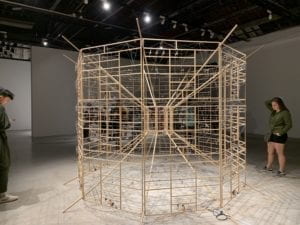Chronus Visit

Visiting the Chronus exhibition was very interesting and I don’t think I would have gotten as much out of it had I not been taking this course. Because we are how to use a lot of the same kinds of tools, I looked at each piece with a curious eye and wondered how it was made. I think that the technological components made each piece even more engaging and inherently interactive because they are not standalone, static pieces that you may find in other exhibitions.
Example One: “Now You Are In the Conversation”
I searched ITP’s project archive for a good example of interactivity and came across Chelsea Chen’s work “Now You Are In the Conversation.” I think this is a perfect example because it highlights a common trend in today’s society–smartphones rendering real life experiences secondary to the art itself. Chen programmed her project to stop working if it detected the human gesture of someone taking out their phone to take a photo or video. This project is not only extremely thoughtful and timely, but also emphasizes the conversational aspect of interaction. By this I do not merely mean the title, but how it actually forces users to interact with the artwork. What’s interesting is this interaction isn’t even necessarily an action or movement, but the act of being engaged and giving something meaningful attention itself. A video of Chen’s project can be found here.
Example Two: “Megatron/Matrix” and “Electronic Superhighway”
It feels blasphemous to critique an artist as respected as Nam June Paik, but I will excuse myself since this is only a critique of the interactivity of his work. I struggled thinking of artwork that was not interactive after focusing so much on interactivity, but I thought of video art. Most of the time, video is not interactive because usually the user or viewer just watches or listens rather than truly engaging. These two video installations, while extremely immersive, are not interactive because there is no two sided conversation between the art and the viewer. A video of these two pieces can be found here.
Interaction Defined
In our group project, we defined interaction as a continuous conversation between two or more corresponding elements. I still lean on Crawford’s understanding of analysis and focus on the listening, thinking, and speaking aspects of interaction. It’s not simply act and react, but rather thoughtful continuous conversation. Chen’s project, “Now You Are In the Conversation” is very interactive because even though there is limited movement, the user actually influences the activity of her project and vice versa. Paik’s work is thought-provoking, but there is no form of interaction involved.